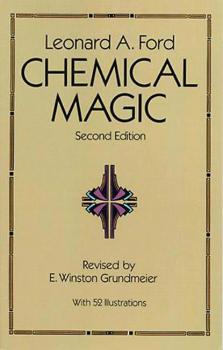ТОП просматриваемых книг сайта:
Dover Books on Chemistry
Скачать книги из серии Dover Books on ChemistryАннотация
For many years, Leonard A. Ford, formerly Chairman of the Division of Science and Mathematics at Mankato State College, Minnesota, devised «chemical magic» shows for a series of college science fairs. In response to many requests, he compiled a volume of over 100 novel demonstrations from those shows. The book soon became one of the most widely used manuals in the field. Its tricks, mystifying and often spectacular, were designed not only to amuse and entertain an audience but to stimulate an interest in scientific principles.Now, with this revised and enlarged republication of Dr. Ford's classic guide, students at both high school and college levels can learn to perform a wide variety of entertaining and educational chemical magic. Here is a dazzling array of stunts and demonstrations dealing with gas liberation, color changes, fires and combustion, smoke and vapors, polymerization, specific gravity, crystallization and precipitation, and many other chemical processes. Professor Ford provides clear and careful explanations for creating cold fire, a disappearing flame and dust explosions; dissolving a glass in water; turning water to milk and back again to water; producing mysterious balloons, heavy air, and magical eggs; and carrying out scores of other intriguing «tricks» with materials available in almost any school laboratory, supply house, or home. Training and experience in handling chemicals are required for the performance of these demonstrations. Dr. Ford outlines directions and safety precautions for each trick. In addition, he supplies helpful suggestions for a line of «patter» to use during performances.Newly revised and updated by Professor E. Winston Grundmeier, this absorbing and unusual book will be welcomed by science educators at the high school and college levels as well as by sponsors of youth and church groups, service clubs, science fairs, and other organizations.
Аннотация
Written in 1661 by the founder of Boyle's Law, a major figure in the scientific revolution of the 17th century, this chemistry classic departs from alchemical tradition by asserting that all natural phenomena can be explained by the motion and organization of primary particles. Contents: Introduction. Physiological Considerations Touching the Experiments Wont to Be Employed to Evince Either the Four Peripatetick Elements, or the Three Chymical Principles of Mixt Bodies. Six Parts. Conclusion.
Аннотация
Clear and readable, this fine text assists students in achieving a grasp of the techniques and limitations of statistical mechanics. The treatment follows a logical progression from elementary to advanced theories, with careful attention to detail and mathematical development, and is sufficiently rigorous for introductory or intermediate graduate courses.Beginning with a study of the statistical mechanics of ideal gases and other systems of non-interacting particles, the text develops the theory in detail and applies it to the study of chemical equilibrium and the calculation of the thermodynamic properties of gases from molecular structure data. The second half offers a lucid, logical presentation of the canonical ensemble and of the grand ensemble, which constitute the theoretical bases for modern advanced equilibrium statistical mechanics. Other topics include the applications of both advanced and elementary theory to a number of interesting problems in physical chemistry — radiation phenomena, the solid state, fluctuations and noise problems, the statistical mechanical aspects of light scattering theory, paramagnetism and magnetic cooling, dielectrics, the theory of electrolyte solutions, nonideal gases, distribution functions for dense fluids, and the Ising model for the study of order-disorder transitions in biological macromolecules. Numerous problems enhance the book's value as a classroom text.



